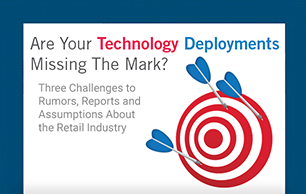
QSR is relying on dozens of technologies to complete the digital transformation. While the primary focus has been on the value of these technologies and their positive effect on customer experiences, there are also many cost savings and operational efficiencies to be gained. Here are 6 cost-saving applications specifically for IOT in QSR.
1. Temperature Monitoring
Temperature monitors are essential to reducing the risk of food contamination and loss due to perishables not being stored at the appropriate temperature. Whether on freezers, refrigerators, deli counters or food cases, temperature monitors can alert management immediately when temperatures fall outside given thresholds. A single proactive notification can save a QSR thousands in food that must be thrown out if it is not properly stored.
2. Managing Perishable Food Items
As IoT devices become more affordable, item-level tracking is coming into focus. By labeling individual packages and/or boxes of perishable foods, IoT can be used to manage perishable foods, indicating which items need to be used first, alerting employees when foods have expired and even tracking the amount of materials thrown away. This information is invaluable for reducing loss due to expired items, evaluating the volume of food waste being generated, and reducing risk associated with use of expired food items.
3. Employee Monitoring
Wearable IOT monitors can be used to measure employee activities to ensure that associates are in the right place at the right time, doing the right things. For example, did an employee wash their hands sufficiently after using the restroom? Did the assigned employee go out to clean the patio seating area? Did they spend a sufficient amount of time in the back to complete the business close checklist? IoT devices can help answer these questions and, in turn, identify training needs and unacceptable employee behaviors.
4. Smart Building Applications
IOT monitors can provide enormous cost-savings by helping to manage items like energy use, temperature control and security. With IoT, basic building functionality like lighting and HVAC can be automatically managed to reduce energy use and expense. In addition, IoT improves security, providing automatic alerts and 24/7 monitoring whether the building is accessed after hours or a break-in occurs.
5. Maintenance of Critical Equipment
IOT monitors can monitor and notify when equipment needs to be maintained. IOT can evaluate criteria beyond simply last date of maintenance and consider usage factors that are impossible for humans to accurately monitor. For example, IoT can be used to track when oil in the fryers needs to be changed based on volume of food run through the fryers, cooking time and other factors. This helps reduce risk of overused oil impacting the flavor of the food and can precisely track how much oil is being used and when new cooking oil needs to be ordered from suppliers.
IoT devices will continue to revolutionize how information is gathered, tracked and used. QSRs have a unique opportunity to take much of the guess-work out of their operations and employee monitoring using IoT devices. For help planning and executing for IoT deployments, contact Telaid.




